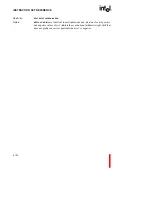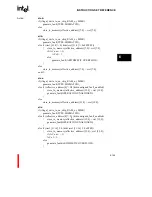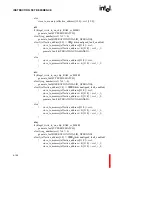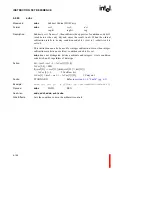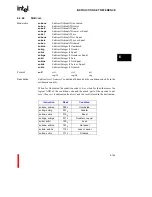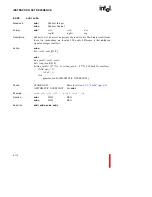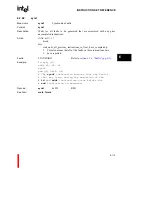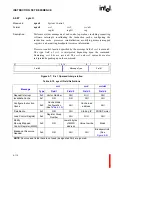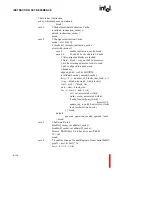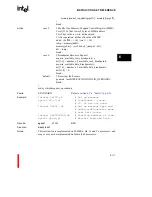
INSTRUCTION SET REFERENCE
6-104
6.2.62
STORE
Mnemonic:
st
Store
stob
Store Ordinal Byte
stos
Store Ordinal Short
stib
Store Integer Byte
stis
Store Integer Short
stl
Store Long
stt
Store Triple
stq
Store Quad
Format:
st*
src1,
dst
reg
mem
Description:
Copies a byte or group of bytes from a register or group of registers to
memory. src specifies a register or the first (lowest numbered) register of
successive registers.
dst specifies the address of the memory location where the byte or first byte
or a group of bytes is to be stored. The full range of addressing modes may be
used in specifying dst. Refer to
section 2.3, “MEMORY ADDRESSING
MODES” (pg. 2-6)
for a complete discussion.
stob
and
stib
store a byte and
stos
and
stis
store a half word from the src
register’s low order bytes. Data for ordinal stores is truncated to fit the
destination width. When the data for integer stores cannot be represented
correctly in the destination width, an Arithmetic Integer Overflow fault is
signaled.
st
,
stl
,
stt
and
stq
copy 4, 8, 12 and 16 bytes, respectively, from successive
registers to memory.
For
stl
, src must specify an even numbered register (e.g., g0, g2, ... or r0, r2,
...). For
stt
and
stq
, src must specify a register number that is a multiple of
four (e.g., g0, g4, g8, ... or r0, r4, r8, ...).
Action:
st:
if (illegal_write_to_on_chip_RAM)
generate_fault(TYPE.MISMATCH);
else if ((effective_address[1:0] !=
00
2
) && unaligned_fault_enabled)
{store_to_memory(effective_address)[31:0]
=
src1;
generate_fault(OPERATION.UNALIGNED);}
else
store_to_memory(effective_address)[31:0] = src1;
Summary of Contents for i960 Jx
Page 1: ...Release Date December 1997 Order Number 272483 002 i960 Jx Microprocessor Developer s Manual ...
Page 24: ......
Page 25: ...1 INTRODUCTION ...
Page 26: ......
Page 35: ...2 DATA TYPES AND MEMORY ADDRESSING MODES ...
Page 36: ......
Page 46: ......
Page 47: ...3 PROGRAMMING ENVIRONMENT ...
Page 48: ......
Page 73: ...4 CACHE AND ON CHIP DATA RAM ...
Page 74: ......
Page 85: ...5 INSTRUCTION SET OVERVIEW ...
Page 86: ......
Page 111: ...6 INSTRUCTION SET REFERENCE ...
Page 112: ......
Page 233: ...7 PROCEDURE CALLS ...
Page 234: ......
Page 256: ......
Page 257: ...8 FAULTS ...
Page 258: ......
Page 291: ...9 TRACING AND DEBUGGING ...
Page 292: ......
Page 309: ...10 TIMERS ...
Page 310: ......
Page 324: ......
Page 325: ...11 INTERRUPTS ...
Page 326: ......
Page 369: ...12 INITIALIZATION AND SYSTEM REQUIREMENTS ...
Page 370: ......
Page 412: ......
Page 413: ...13 MEMORY CONFIGURATION ...
Page 414: ......
Page 429: ...14 EXTERNAL BUS ...
Page 430: ......
Page 468: ......
Page 469: ...15 TEST FEATURES ...
Page 470: ......
Page 493: ...A CONSIDERATIONS FOR WRITING PORTABLE CODE ...
Page 494: ......
Page 502: ......
Page 503: ...B OPCODES AND EXECUTION TIMES ...
Page 504: ......
Page 515: ...C MACHINE LEVEL INSTRUCTION FORMATS ...
Page 516: ......
Page 523: ...D REGISTER AND DATA STRUCTURES ...
Page 524: ......
Page 550: ......
Page 551: ...GLOSSARY ...
Page 552: ......
Page 561: ...INDEX ...
Page 562: ......
Page 578: ......













